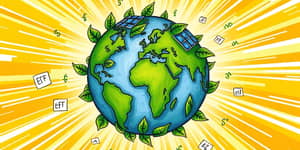
In a world awakening to the intertwined fate of our planet and prosperity, investors have a unique chance to support conservation while pursuing financial sustainability. rapidly growing biodiversity finance sector offers a pathway to align purpose and profit, especially within emerging markets rich in natural wonders. This article guides you through the growth, opportunities, and strategies behind biodiversity funds that target some of the globe’s most critical ecosystems.
Global awareness of biodiversity’s economic and environmental value has soared, prompting a surge in dedicated investment vehicles. In the year to September 2024, assets under management in biodiversity-focused funds 50% year-on-year growth. This remarkable expansion reflects a shift in investor priorities, from traditional returns to meaningful, nature-positive outcomes.
Governments and institutions worldwide are integrating biodiversity goals into their frameworks. The Global Biodiversity Framework, alongside the Paris Agreement, has catalyzed public and private commitments. As regulatory standards tighten, the need for reliable, transparent impact measurement grows. Initiatives like the Taskforce on Nature-related Financial Disclosures (TNFD) are setting the stage for standardized reporting, enabling investors to compare and trust fund performance.
Emerging economies such as Brazil, China, Indonesia, and India occupy the epicenter of biodiversity finance. Their vast rainforests, coral reefs, and unique fauna deliver extensive ecosystem service value—from carbon sequestration to water purification. Yet these ecosystems face significant land-use change threats, underlining the urgency for capital flows that foster regeneration.
Smaller emerging markets also present intriguing prospects. Nations with high threat scores but efficient regulatory environments can deliver higher venture-style return potential, rewarding investors for their bold early commitments.
Investors seeking nature-positive exposure can choose from a growing array of instruments tailored to different risk appetites and return expectations:
Bond funds—both labelled and unlabelled—play a critical role. The Goldman Sachs Biodiversity Bond Fund, for example, integrates SDG-aligned issuers across developed and emerging markets, financing projects that preserve habitats and restore degraded lands.
The pace of growth is nothing short of inspiring. Approximately $166 billion flows annually into biodiversity finance, with private investment rapidly gaining share. Thematic funds focusing on nature now represent around 2.9% of global equity assets, up from a fraction just five years ago.
Emerging markets inherently carry higher volatility and political considerations. However, the risk often mirrors reward—as projects combating deforestation or habitat loss can deliver robust environmental, social, governance outcomes alongside financial gains. Investing in early-stage or credit markets demands patience and due diligence, but it also unlocks potential returns unattainable in more mature sectors.
Key risks include regulatory shifts, currency fluctuations, and verification challenges. Investors should look for fund managers with local expertise, transparent impact frameworks, and partnerships with NGOs or multilateral institutions such as the World Bank and IFC.
Beyond financial metrics, biodiversity funds catalyze on-the-ground change. Capital directed toward organic agriculture, for instance, reduces pesticide use and supports healthier soils. Investments in sustainable forestry foster jobs in rural communities and safeguard critical carbon sinks.
By channeling resources wisely, investors become stewards of nature’s bounty, ensuring that prosperous communities and thriving ecosystems advance hand in hand.
The convergence of environmental urgency and financial innovation presents a golden moment for biodiversity funds with emerging market exposure. With strong policy frameworks, pioneering financial instruments, and a rising tide of investor demand, capital can flow to where it is most needed. By embracing this movement, you not only position your portfolio for growth but also contribute to the lasting health of our planet.
Let your investments be a force for restoration, resilience, and renewal—aligning prosperity with preservation in the world’s most vital natural frontiers.
References













